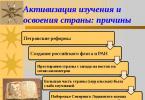Let's talk a little more about the ways of forming words in the Russian language. Now we will talk about in a suffixless way.
This method produces exclusively nouns.
The basis for their formation is Verbs And adjectives.
How does word formation occur?
If with the suffix method to productive basis(the one from which a new word is formed) the suffix is added ( fog - fog - n th), That with the suffix-free method, the suffix is truncated(it disappears), as a result of which a new word is formed.
Tell - story.
Transition – transition.
Green - greenery (in this case, the basis of the noun became the productive basis of the adjective without any truncation- it happens!).
And now about the notorious “pitfalls”!
I would like to warn you against a mistake that even very well-versed students make.
Probably, having looked at the examples above, some of you are now also asking yourself the question: why not the other way around? So simple: story - story.
The word is formed suffixal way!
No! This is the wrong move!
Let's pick cognates: to tell, to tell, skaz, to tell, story .
Let's think about which of the words closer to each other in meaning?
Certainly, story And tell.
"Story" – This "the result of storytelling." Means, first you need to “tell” something in order to get a “story”. Method of word formation story– suffixless.
This is how the word-formation “chain” is built:
Tell - tell - tell - story - storyteller.
Conclusion No. 1.
Words are formed in a suffixless way if the action becomes the result of the action(verb - noun).
*Note. Of course, not all “short” nouns are formed in a suffixless way. For example, borrowed nouns " doctor"(from Staroslav. " doctor") And " harm"(from Staroslav. " vered") provided the basis for the formation of verbs " heal" And " harm».
The word-formation “chain” in this case looks like this: harm - harm-and-t - to harm - to damage - to be damaged.
How is a noun formed? greenery?
We select cognates: turn green, green, green, turn green, green.
Which of the words closer in meaning by the way greenery?
Green, Certainly!
Green – colors of greenery, grass, foliage(qualitative adjective), and Greenery – something green(a collective noun that also denotes quality).
What comes first? 
Should have appeared first green color so that later something was named greenery.
Method of word formation greenery – suffixless.
Conclusion No. 2.
Words are formed in a suffixless way if the separately named quality goes into something new quality, which becomes the essence of any phenomenon(adjective – noun).
And now the question: How are the words formed: dinner, sushi, overnight, escape, hacksaw, contribution?
Did you manage? Fine! Want to test yourself? We are always happy to help you!
Still have questions? You don't know how the word was formed «
greenery »
?
To get help from a tutor, register.
The first lesson is free!
website, when copying material in full or in part, a link to the source is required.
Basic methods of word formation (non-suffix, suffix, prefix...)
Let's move on to B
B1
Teacher's comments on the material being studied
| Possible difficulties | Good advice |
| Sometimes it can be difficult to determine how a word is formed, for example: no one, break. | To determine the method of formation of a given word, you need to identify its base and select a cognate word (s) that is closest in composition and meaning, i.e. including as many of the same morphemes as possible and related to it lexically, for example: no one ← to whom. Most often, as in this case, the generating stem has fewer morphemes than the derivative. However, sometimes the opposite happens: a new word is formed by truncating the suffix and shortening the stem, for example: break ← take a break. Then you need to compare the composition of the word being analyzed and the closest related word and establish the method of word formation. So, for example, the word nobody is formed in a prefix way, and the word break is formed in a suffixless way. The formation of a word is sometimes accompanied by alternation, which can raise doubts about from what base and in what way the given word is formed, for example: scatter ← scatter (suffixless). |
| The most common mistake when determining the method of word formation is the incorrect selection of a word with a generating stem in the word formation link, as a result of which the method of word formation is also incorrectly determined, for example: transition ← move (prefix method). | According to the lexical meaning, the word transition is closer to the verb transition than to the noun move, therefore the word with a generating stem in this case is the verb transition, from which the word transition is formed in a suffixless way: transition ←transition (suffixless method of word formation). |
| Derivatives and prefixes of foreign origin can be confused with the root and, as a result, the method of word formation can be mistakenly identified as addition, for example: supernova, post-industrial. | Remember the most common prefixes that should not be confused with the root: inter-, over-, super-, post-, counter-, dis-. |
Basic ways of forming words in Russian
Words in the Russian language are most often formed from other words in the following ways: by adding prefixes and suffixes, by addition, by moving a word from one part of speech to another.
Forming words using prefixes and suffixes
A word can be formed from another word by adding a prefix. This method of word formation is called prefixing. In prefix word formation, the new word belongs to the same part of speech as the one from which it is formed.
Run - run away. (Both words are verbs.)
School - pre-school. (Both words are adjectives.)
Grandfather - great-grandfather. (Both words are nouns.)
A word can be formed from another word by adding a suffix. This method of word formation is called suffixal. Unlike prefixes, many suffixes are capable of forming words of another part of speech from words of one part of speech.
House - house-ik. (The suffix -ik- adds a diminutive meaning. The part of speech does not change.)
Strength - strong. (The suffix -n- helps form an adjective from a noun.)
Surprise - amazing. (The suffix -teln- helps form an adjective from a verb.)
A word can be formed from another word by simultaneously adding a prefix and a suffix. This method of word formation is called prefix-suffixal.
Fast - speedy. (The prefix u- and the suffix -i- help form a verb from an adjective.)
Yes - yes. (The prefix na- and the suffix -sya- contribute to the formation of a verb with the meaning of maximum completeness of action from another verb.)
A special way of word formation is suffixless. Usually, in this way, nouns with the meaning of action are formed from verbs: beg-a-t - run. In case of suffixless word formation, the suffix is not added, but, on the contrary, disappears (truncated).
Transition - transition. (Truncation of the suffix -i- helps form a noun from a verb.)
Scream-a-scream. (Truncation of the suffix -a- helps form a noun from a verb.)
Less commonly, nouns are formed from adjectives using a suffixless method. In this case, during word formation, suffixes are not truncated; they are not used at all.
Deaf - oh - wilderness - . (The noun is formed from an adjective without the help of a suffix.)
Quiet - quiet - . (The noun is formed from an adjective without the help of a suffix.)
Forming words using addition
With the help of addition, complex words are formed by combining parts of several words into one. In this case, two complete words, as well as several stems, can be combined into a single whole.
When adding whole words, the first part of the resulting compound word usually does not lose its ending; both parts of the compound word are declined:
launch vehicle, (in) launch vehicle, launch vehicles.
When adding the bases, the first part of the resulting complex word is no longer capable of independent change: raincoat-tent, (in) raincoat-tent.
The addition of stems usually occurs with the help of connecting vowels -O-, -E-, -I-.
Dark-O-skin (from the phrase dark skin).
Coal-E-mining (from the phrase mine coal).
Seven-and-year-old (from the phrase seven years).
Sometimes when adding stems, connecting vowels are not used. This usually happens in words where the first part is not the complete stem, but a part of it. In such cases, not only the first stem is often reduced, but also other stems of the words from which the given compound word is formed.
Wall newspaper (from the phrase wall newspaper).
Special correspondent (from the phrase special correspondent).
FSB (from the phrase Federal Security Service).
A special case of addition is considered to be fusion. A frequently used phrase sometimes turns into a single compound word. In this case, stems are not shortened and connecting vowels are not used.
Deprived of mind - insane. (There is no connecting vowel in this word, because the word in r.p., singular with the ending -a merged with the word that follows.)
Instantly soluble - quickly soluble. (This word does not have a connecting vowel -O-, because the adverb with the suffix -O- merged with the word that follows.)
Formation of words by moving a word from one part of speech to another
New words can be formed by moving a word from one part of speech to another. The external form of the word may not change.
Dining room (room) - (factory) dining room. (The adjective dining room has become the noun dining room.)
Duty officer (cadet) - duty officer (at the entrance). (The adjective duty has become the noun duty.)
The transition from one part of speech to another is very typical for Russian word formation. Below are the most common types of such transitions.
| Transition from adjective to noun. | Duty officer (student) - duty officer (at the entrance). |
| Transition from participle to noun. | Manager (production person) - (chief) manager. |
| Transition from participle to adjective. | Leader (vessel navigator) - leader (specialist in the department). |
| Transition from participle to adverb. | (Witty) jokingly - carried the log jokingly (i.e. easily). |
| Transition from adverb to preposition. | (Walked) around - (Walked) around the house. |
| Transition from participle to preposition. | (Be careful), including (gas) - (everyone came), including Vadik. |
There are several ways of word formation.
1. Morphological, which consists in creating new words by combining morphemes according to the rules existing in the language. This method includes prefix, suffix, prefix-suffix, suffixless, addition.
2. Lexico-semantic method, here a new word is created by splitting the old one into two or more homonyms. For example, a boxer is a breed of dog, a boxer is a boxing athlete.
3. Morphological-syntactic - the formation of a new word by moving it from one part of speech to another: canteen, ice cream. In this case, the word acquires new grammatical features.
4. Lexico-semantic, which consists of creating a new word by merging a combination of words into one lexical unit. For example, evergreen, this hour – evergreen, now.
Prefix method. Words are formed in this way by attaching a prefix to the original word. The new word belongs to the same part of speech as the original one. Thus, nouns are formed (for example, light - dawn, move - exit); adjectives ( tasty – tasteless, sonic – supersonic); pronouns ( someone, somebody, nobody); Verbs ( walk - come in, approach, leave); adverbs ( through - through, always - forever, yesterday - the day before yesterday).
Suffix method. A suffix is added to the base of the original word.
Words formed in this way can be either the same part of speech (for example, forest – forester), and different (for example, forest - forest). The suffix is not attached to the whole word, but to its stem, and sometimes the stem is modified: for example, cast - casting, weaver - weaver.
Prefix-suffixal. Both a prefix and a suffix are simultaneously attached to the original word, for example homestead, plantain, equestrian, Moscow region. Most often, nouns are formed in this way. (background, window sill); Verbs (get carried away, sign); adverbs ( in Russian, in spring);
Suffixless method is that the ending is discarded from the word ( black – mob) or the ending can be removed and the suffix ( rest - rest, scold - scold);
Addition. This is the formation of a new word by combining two words or two or more stems into one verbal whole. Words formed as a result of addition are called complex. Compound words are formed:
1) adding whole words, for example: boarding school;
2) adding words, for example: head teacher, salary;
3) addition using connecting vowels O And e, For example: pathfinder, farmer;
d) adding initial letters, for example: ATS, Moscow State University;
4) adding initial letters, for example: Youth Theater, Moscow Art Theater.
Word formation (WF) is the linguistic process of forming new word forms using various stable models. Also, word formation is an area of scientific knowledge that is devoted to the study of this process. Let's look at ways to form words in .
In contact with
The entire array of word forms of our language is classified into primitives (their meaning cannot be explained) and derivatives (their meaning is explained by the structure - the internal form of the lexeme). Eat two different ways to form words:
- diachronic(historical formation);
- synchronistic(the actual formation of new word forms).
As mentioned earlier, the creation of new ones is based on fixed word-formation models. The methods of formation of verbs and nouns are very diverse. The CO model is a kind of language algorithm for producing new word forms or establishing the internal structure of old ones.
Goals and functions of the CO
Why does the process of forming new units in our language exist, what functions does it perform? First, new tokens are created in order to simplify syntactic structures, which model this or that object of reality (a lighter is something that lights a flame). Secondly, word formation is capable of fixing meanings in different syntactic models (washing is a verbal noun denoting a whole process of actions). Thirdly, the formation of new words is aimed at conveying stylistically or emotionally charged shades (spirit - soul - soul).
In addition, word formation performs the following important functions:
- Nominative - designation, name of any objects and processes.
- Compressive – creating abbreviations from a number of words, simplifying the language.
- Constructive - changing a word in order to correctly construct syntax.
- Expressive – conveying a subjective, personal attitude towards something.
- Stylistic – expression of the stylistic coloring of a word form.
Educational means
The structure of each word can be represented as follows: stem (the part that reveals its meaning) and inflection/ending (the element located at its absolute end and expressing grammatical characteristics). During formation, the inflection always changes, but the stem does not.
Exists two types of bases in CO: generating and derivative. Generative - simpler in meaning, it is basic for the formation of a derivative basis.
Important! The derivative is always secondary and justified by the meaning of the producer.
The stem consists of morphemes - elements (root, prefix, suffix, ). Morphemes indicate CO patterns. Some of the morphemes are word-forming; they are the means of creating words:
- prefix (prefix) – an element located before the root;
- suffix - an element located after the root of the word form;
- postfix (s) – an element located after the suffix and expressing reciprocity/reciprocity.
Also, the combination of a prefix and a suffix plays the role of a CO means - in this case, they are added simultaneously.
Types of word formation
In our language there are a large number of options for forming word forms. Let's list them:
- Prefixal (prefixive way of forming words).
- Suffixal.
- Prefix-suffixal (prefix-suffixal).
- Postfixed.
- Suffixless.
- Fusion (of words or their stems, abbreviation).
- Substantivization (transition of a word to another part of speech).
- Complex types.
Now let's look at each of them in detail.
 Prefixal or prefixed way of forming words– a variant of word form formation in which the prefix () becomes the word-forming morpheme. The prefixal method is characteristic, as a rule, of verbs and verbal parts of speech, but is also involved in the formation of other words.
Prefixal or prefixed way of forming words– a variant of word form formation in which the prefix () becomes the word-forming morpheme. The prefixal method is characteristic, as a rule, of verbs and verbal parts of speech, but is also involved in the formation of other words.
Suffix CO– a type of word form formation in which the suffix becomes the word-forming morpheme. Suffixation is a nominal property, but is used in the formation of many other parts of speech.
Examples of prefix CO: green - turn green, eye - peephole.
Prefix-suffix CO– a combined process in which a prefix and a suffix become word-forming morphemes. The prefix-suffix method is typical mainly for nouns, as well as adverbs.
Examples of prefix-suffix CO: three - three of us, blanket - duvet cover.
Postfix CO– postfix acts as a word-forming morpheme. The postfixal method of word formation is characteristic of verb forms and characterizes their reflexivity or reciprocity of action.
Examples of postfixal CO: return – return, push – push.
Without suffix CO– truncation of word morphemes. The suffixless method is used to transform verbs and some adjectives into nouns. What is typical for this variant is that the base of the generating adjective changes, but the verb does not.
Examples of suffixless CO: deaf - wilderness, walk - step.
Fusion (addition) in word formation occurs in various variations:
- merging stems or whole words using connecting vowels (“o” and “e”);
- abbreviation - the formation of complex abbreviated words by connecting parts of phrases. This type is most typical for nouns.
Examples of fusion in CO: nature + know = natural history, genetically modified organisms - GMOs.

Substantivization– word formation of nouns, the process by which participles and adjectives are transformed. This process is also called the transition from one part of speech to another.
Examples of a word transitioning to another part of speech: working people - the worker gets up early.
Complex prefix and complex suffix CO- these are combined processes of word formation, during which the prefix or suffix act as word-forming elements or the fusion of stems occurs.
Examples of complex varieties of CO: snow + cleaning + -n = snow removal, heat + travel + -ohm = by motor ship.
Important! CO methods are stable models that are characteristic of specific parts of speech and are applied according to a fixed algorithm.
Word-formation analysis
CO parsing is the process of dividing a word into parts with the establishment of internal connections. Its implementation is aimed at finding out from to what word form and how the word was formed, as well as what models were used.
CO word parsing is performed using the following algorithm:
- Put the word in question into its initial form.
- Identify lexemes that could motivate the creation of the word under study. They must be connected with it in meaning, and the meaning of the word being analyzed can be explained through them.
- Define derivative and generating bases.
- Indicate the means and method of CO in the lexeme under study.
- Determine what processes were associated with the formation of a new word form (truncation of the stem, etc.).
Example of word-formation parsing:
- Wealth is the initial form of “wealth”.
- Wealth (noun) – comes from the adjective “rich.”
- Wealth (derivative) ← rich (producing).
- The means of CO is suffixation, the method of CO is suffixation.
- No other processes were involved.
Methods of word formation
2 Basic ways of forming words in Russian
conclusions
So, word formation represents a set of linguistic processes and stable algorithms for the formation of word forms. There are many types of word formation that are based on the use of different morphemes to create a new word.
“Root in related words” - A word with an unstressed vowel. I will rise towards the sun like an ear. Wheat ear. Let's rest. Bread. Be healthy. Spelling of roots in related words. Knead the dough. Unchecked dictionary spellings. Guess. Vocabulary work. Ability to write the root correctly. The root is in related words. The fourth one is extra. Spikelet.
“Word formation of verbs” - Lesson topic: Conclusion. Spelling of word parts. Word formation of verbs. Lesson objectives: Work on the topic of the lesson. But still we are not used to retreating! Spelling of prefixes Spelling of suffixes Spelling of unstressed endings. Verbs. Tell. Verbs are formed. Dynamic pause. The nut of knowledge is hard.
“Formation of gerunds” - Kuzka looked around. Verb. Diadochos. Formation of participles. Participles with suffix. Yaga turned around. Test. Egg shell. Adults don't like to play. Answer the question. Kuzka came out. Match A. Shahgeldyan’s drawing with as many phrases as possible. Which participles are formed correctly. Participles.
“Formation of word forms” - Forms. Words in which the stem remains the same. Solar. Word forms. Lesson. The walls of the room sparkled with bright colors. Magic lesson. Smiling orange sun. Parents - the Suns - worked - they illuminated and warmed the Earth. Similar words. The sun was very small. The Sun - Dad and Mom - the Sun looked at the Sun's pranks with a kind smile.
“Word-forming means” - Evaluation criteria. Little book. Write down the word. The meaning of subjective evaluation suffixes. Mouse in a hole. Cap. Companion. Little book. Little mouse. Selective dictation. A word formed in a prefix-suffix way. Words with diminutive suffixes. Mama. Expressive word-formation means.
“Related words” - In relation to the previous words, it is not related. Preparation for the Russian Language Olympiad. From the Bible. Burning ships means a decisive break with the past. Breguet is a watch company, here it is “watch”. Etymology 30. Don’t go on the road so often In an old-fashioned dilapidated shushun. Penates are ancient spirits that guarded the peace of the family.
There are a total of 24 presentations in the topic




